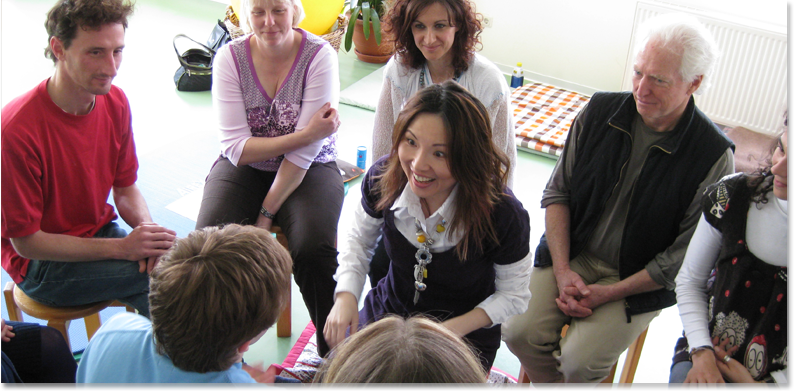How does a PDL language course progress?
First Steps with Psychodramaturgy for Language Acquisition (PDL)
In the following, we will describe what can be experienced during the first few days of a PDL beginners‘ course as held by a qualified PDL trainer.
In the first week of an intensive course (3 to 6 units per day), a progression is followed that offers the participants an introduction to the foreign language in a protected environment.
In the second week of a course lasting longer than one week or on the third weekend of the weekend course variant, the trainer can choose from a wide selection of activities and techniques that are suited to the linguistic and communicative needs of the participants. Below you will find the description of an example for such an exercise (The Chairs).
Why is the Intensive Course Preferred?
PDL courses in their basic form are mostly offered as intensive courses that take place over a number of weekends (e.g. from Friday 5pm to Sunday 2pm), or over a number of weeks (generally 25 to 35 hours depending on the organizer), or in evening classes. The intensity of such courses allows the participants to experience and acquire the language more effectively and also allows for a deeper development of those capabilities and skills required for learning a foreign language (see: Characteristics of PDL).
Most PDL techniques can, however, also be employed in more extensive and / or long-term courses.
Group Size
PDL courses normally take place in small, heterogeneous groups. In the first week, the ideal size of an intensive course is between 8 and 12 participants (for us, 14 is the maximum). After that, the groups may be larger. With slight changes to the parameters, most PDL exercises can also be effective in larger groups as well as in one-to-one courses.
Levels
Due to the uniqueness of PDL exercises, participants of different levels can work together and benefit from the difference in levels. Students with the following levels can work together:
- Beginners and Elementary
- Elementary and Intermediate
- Advanced students who wish to improve their general skills in order to communicate better or to read press or literature in the target language and students who wish to master particular situations (e.g. business situations).
PDL - courses may be offered to adults, young people and children.
1. The Introduction to the Foreign Language
In the first few days, each individual
is introduced to the foreign language
individually and at his own pace and rhythm.
In the following we will describe the classic progression of the first day of an intensive course for beginners. This shows how a participant with little or no knowledge makes his first steps in the foreign language. Generally, the first week follows a precise progression that allows the participants to experience and discover the foreign language step by step.
With elementary and more advanced students, the progression allows the participant first to be re-introduced to the flow of the foreign language individually (see below: Doubling on Verbal Impulse). After that, direct encounters with other participants take place . Some of the first steps described below would then be skipped.
1.1 First Day: Empathic Doubling
On the first day, the participant should make positive contact with the foreign language and experience the foreign language fluently from the very start. They are first familiarized with the rhythm, melody and articulation of the foreign language and at the same time they develop their own first core of the foreign language, which can then be used to establish the direction or content of the language on the second day.
The Relaxation
Every course day begins with a relaxation exercise. Depending on the location, this relaxation exercise occurs lying down (the most effective method) or sitting. This exercise not only serves to relax and thus be more receptive, but also to:
- To break away from everyday life and concentrate better on what happens in the course, and to “arrive” at the course better.
- To increase the accessibility to and receptiveness for the foreign language; significantly supporting language acquisition.
- Increase concentration
- Strengthen self-confidence
- Make first contact to the rhythm and melody of the foreign language in a calm and receptive state
- Allow beginners to learn basic vocabulary for parts of the body.
The relaxation employs the “Sandwich Principle”; a “slice” of the foreign language, a “slice” of the native language (to understand and follow the instructions better) and a “slice” of the foreign language (to have a chance to hear and understand the phrases in the foreign language better). After a few days, when the participants have integrated the progression of the relaxation, this exercise is done in the foreign language only.
Warming Up: The Group Mirror
Tuning in to the foreign language
In the first warming up exercise, the participants are prepared for the main exercise. They are introduced to the rhythm, melody, articulation and at the same time to the gestures of the foreign language. Every language possesses its own particular body dynamic and the participants are made aware of this so that they can perceive and pick them up more effectively.
The participants sit or stand in a circle and mirror and echo the gestures, sounds and statements of the trainer, introducing the participants into the foreign language in a usually poetic sequence. They should have the feeling of being in a protected environment when making their first steps in the foreign language and that they are can speak in a normal rhythm.
The Main Exercise: Empathic Doubling
Le double : un monologue à deux.
The doubling: a monolog for two.
Every individual is then individually introduced to the rhythm and melody of the language. The first individual exercise allows participant to familiarize themselves and to feel at home with the language. The doubling exercise also brings the participants from the very start into the flow of the foreign language.
As the trainer sits right behind the participant and speaks directly into the ear, the participant can hear the sounds of the foreign language very well in audible conditions created to allow the perception and reproduction of the pronunciation.
This exercise entails three phases and each phase fulfils a particular function.
1 - The Full Mask
The participant first wears a neutral mask that covers the entire face. As the participant can neither see nor speak, he can only listen. He can thus concentrate on the voice of the trainer and the sound, rhythm and melody of the foreign language.
The trainer attunes to the participant’s breathing rhythm to identify as much as possible with the participant. Starting from the breathing rhythm, she offers him a short language sequence of about one and a half to two minutes that she then repeats to make it more familiar for the participant. The participant feels gently immersed into the foreign language.
2 - The Blind Half-Mask
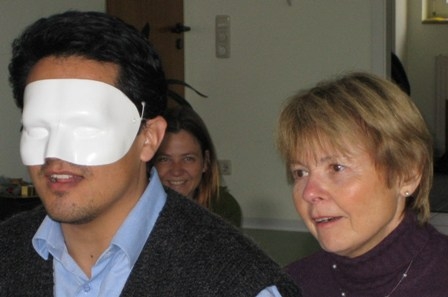
Language tailored for you.
The participant then wears the blind half-mask (see picture) that allows him to speak. The trainer repeats the sequence, and he can try to reproduce the sounds and rhythms and feel how it is to produce them in his own mouth. The trainer adapts herself to his rhythm and expands slightly on the parts that he seems to take over with some enthusiasm: she offers him other ways to express the same things. She accompanies him gently in his first steps in the foreign language. The language she offers him is tailored for him.
3 - The “Open Half-Mask”

The participant then wears the third mask (see picture) which allows him both to see and to speak. He often becomes aware that he is not only talking to himself, but also to the others whom he can see.
The trainer offers him the sequence again which is further suited to and even more familiar to him.
In-between exercises
After two participants have experienced the doubling exercise individually, a so-called in-between - exercise is held. This exercise can be a short poem in the foreign language or a rhythm exercise to raise the awareness of the peculiarities of the foreign language. It can also be an exercise designed to develop certain skills vital for the acquisition of the foreign language: sensitivity, empathy, receptivity, flexibility, spontaneity. The course then proceeds with the doubling exercise for two other participants.
Frequently asked questions about the first day
Why are the neutral masks used on the first days?
The neutral masks are used often in the first four days. The “blind” masks enhance concentration on the sound of the foreign language. As sight is disabled, audio perception is increased. It also enhances the receptivity for and the acquisition of the language. The masks also have a protective function: one feels different and safer behind the mask.
Why are the courses mostly held on without tables?
Classic PDL courses are usually held on the floor in a room without tables. The participants sit on chairs or lie on mats or cushions as they please. This allows the participants greater mobility and freedom of movement. The communication amongst the participants can develop better as no obstacles are between them. The participants can also adopt the position they find most comfortable at that moment. The setting for the exercises can be arranged more rapidly. The relaxation exercises are preferably held lying down, which increases their effectiveness. Naturally, if the participant wishes and depending on the location, the exercises can be held on chairs or stools (stools are to be preferred as they are easier to move).
What do the other participants do while the protagonist is being doubled?
During the first days, we recommend to the other participants that they identify with the protagonist; i.e. they imagine being in his place. This identification encourages the acquisition of the language. The participants also develop an important communicative skill: putting oneself in the shoes of another person and so to understand this person from within. In this phase, we often observe that many participants mouth or whisper the suggestions of the trainer synchronously with the protagonist. In some exercises, we invite the participants to be the direct echo of the protagonist.
1.2 Day Two: Doubling on Verbal Impulse
On the second day, the participants give the directions and topics of the sequences. They also steer the sequence with the way they react to (and accept or reject) the trainer’s suggestions.
Warm Up: The Intonational Promenade
In the warming up exercise, the participants move around the room uttering a word, phrase or sentence. First to themselves and then to the other participants, they try to express their phrase in different ways, varying their rhythm and intonation, becoming aware of the change in meaning the intonational variations produce. This is then repeated with another word or phrase.
This exercise is there to habituate the participants to the importance in communication not only of the “what”, but also of the “how” something is said. It demonstrates that even with few language skills, one can expand one’s range of expression with the help of intonation.
Main Exercise: Doubling on Verbal Impulse
On the second day, the protagonist first wears the blind half-mask. He concentrates on his breathing and spontaneously utters a word or a sentence. Using this short statement, in particular its intonation, the trainer offers linguistic expansion. Judging by the protagonist’s enthusiasm when taking over the verbal suggestions, she adapts this expansion to fit the protagonist’s wishes as much as possible, leaving out what the protagonist doesn’t echo or only echoes out of politeness and emphasizing what he echoes enthusiastically. The sequence is then repeated, strengthened or further expanded with the open half-mask.
With “false” beginners, intermediate, or advanced participants, this is the recommended exercise to start off with. The protagonists don’t say just one word, but as much as they can and want. The trainer supports them and in the charging phase, helps them to make their statements more fluent, precise and correct.
1.3 Day Three: The Trainer's Mirror
The mirror: From the monologue to the draft of the dialogue.
On the third day, the so-called "Trainer's Mirror" takes place. Whereas during the first two days, the trainer adapted and tuned herself to the participant, in this mirroring exercise, it is the protagonist who adapts himself to the trainer. The protagonist should learn to put himself in the shoes of his counterpart, in order to understand and communicate better.
-
Generating a Sequence
The trainer wears the blind half mask and concentrates on herself and allows a short sequence to arise. In this phase, the participant, who sits in front of her and also wears a blind half-mask, just listens to the sequence. When the trainer repeats the sequence, he echoes it.
-
Exchanging Places
Participant and trainer exchange places. The trainer repeats her sequence and the participant, who now wears an open half-mask, not only echoes it, but mirrors the gestures and movements of the trainer, allowing him to identify himself even more with the trainer.

Mirroring the Trainer.... Place reversal
-
Returning to one’s place
The participant and the trainer return to their original places, both without masks. The trainer repeats her sequence one more time. The participant has two options this time: he can either echo the trainer or react, or first echo and then react and echo again, or vice-versa. In this phase, we often see the beginnings of dialogues.
1.4 Further exercises in the first week
As we cannot describe in detail each phase of a PDL course, we would like to outline a few of the next steps here.
On the third day, the “mirroring the participant” exercise takes place. The participant first expresses himself using, facial expressions and gestures. He then tries to accompany the body language sequence with language. The trainer here supports him, and then takes over his role to make the sequence more fluent and precise. In the last phase, the participant tries to repeat the sequence alone. If necessary, the trainer can offer a little help here.
On the fourth day, dialogues with the trainer that suit the level and abilities of the participants take place (triadic encounter).

From Doubling ... to dialog.
(in the "triadic encounter" with the trainer)
As of the fifth day, the participants conduct dialogues with other participants (mute dialogue, encounter in polarity ...). With beginners, these dialogues are initially understandably bumpy. The trainer helps them in the “charging phase” to perfect and correct the sequence.
Then, encounters with several participants take place. The whole group now participates directly in the events.
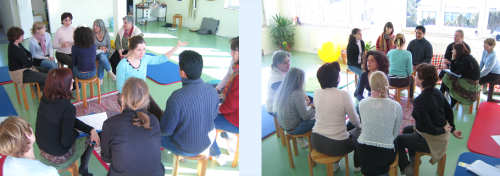
Two subgroups preparing the encounter of the two protagonists
In the later stages of language acquisition, the various activities, texts, and/or pictures are now chosen by the participants and reflect the group dynamics and needs.
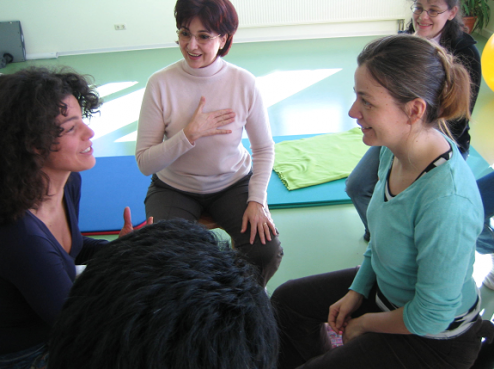
The two protagonists meet, supported by their subgroups
Techniques of support
Various techniques are employed to support the participants in their wish for expression. We can take the “Chairs”, a group projection exercise (described in detail below), to illustrate these techniques:
- Expansion techniques begin with the participants’ wish for expression and allow the participants to acquire more language and develop their range of expression (see picture of “Charging”).
- The loading techniques allow the participants to practice and use the language offered to them in a protective environment, and facilitate language acquisition. They also serve to expand and, at the same time, correct the participant’s palette of expression.

Preparation of the encounter of two protagonists in subgroups
- Retake techniques ensure that the teaching process isn’t linear. They also ensure that there is an opportunity for the new language in a scene to be reworked. Participants have the chance to use and expand on what they have said under slightly modified conditions. Through a change being made to one or more parameters of the scene, participants can experience a sense of “change in continuity”: they have the impression of revisiting their new language, rather than “just” reproducing it. They therefore can remember and employ the new language better and more flexibly. These techniques therefore serve to expand the participants’ range of expression and their flexibility in functioning in and performing different roles.
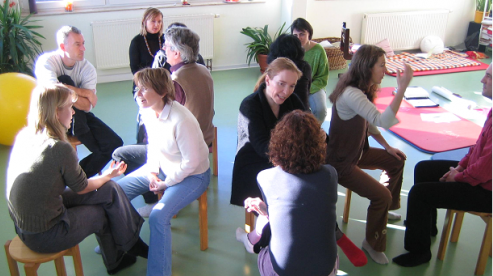
Dyadic encounter
2. Group Dramaturgy
From the second week of an intensive course (or on the fifth weekend of a weekend - based course), the trainer can decide which exercises suit the group dynamics and group expectations most. These exercises are also easily adaptable to fit other classes and contexts.
If participants wish to prepare for particular personal or professional situations, these situations can be set up with the aid of psychodramaturgical techniques; thus a strong relationship is created between the needs of the participants and their training.
Situations, topics, texts, pictures, paintings, fantasy trips, statues / freeze frames and postures can be the triggers for such situations. Association, identification, and projection techniques can also be used.
To illustrate these points, we will take the “Chairs” exercise as an example. This technique is described in more detail in Dufeu: 1995, 150-152 and Dufeu, 2003, 34-35 (see Bibliography).
A group projection: The Chairs
This technique also illustrates the distinction between Psychodrama and Psychodramaturgy. This exercise is used with elementary and more advanced participants. It rests on projection techniques that have their origin in Psychodrama (I first experienced this technique with Zerka Moreno in the International Centre for Psychodrama in Barnstaple). In Psychodrama, the participant projects a person onto a chair with whom he then holds a dialogue (therapy for the individual). We have adapted the principle of projection to fit the pedagogical field. However, we use more than one chair and invite not one person, but the whole group to suggest a situation. These two fundamental differences, group instead of individual projection, projection of a situation instead of a person, allow us to transform this technique from a therapeutic into a pedagogical one.
The creation of the situation
Chairs are arranged in the centre of the room, e.g. two chairs facing a third. This constellation becomes a projection screen for the imagination of the group. The group suggests possible situations the chairs could represent. One participant takes note of the suggestions. The list is read out and each participant can vote on which two situations should be enacted. A second round of voting decides which of the two situations is chosen. By following this method, we arrive at a situation in which the group itself decides on the scene to be developed. We owe this technique of multiple rounds of voting, which strengthens the group selection process, to French psychodramaturgist Pierre Bour.
The roles for the situation are very often selected together with the situation itself, for example a job applicant sitting in front of the head of HR and the head of the department, a couple at the registrar’s office(justice of the peace) wishing to be married, parents visiting their child’s teacher, a suspect sitting in front of two police officers.
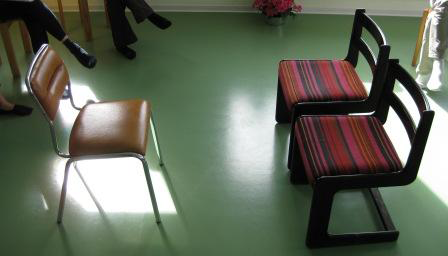
The Interview
The participants then form groups of four (e.g. in a group of twelve). In each group, three participants take up the roles available in the situation, while the fourth person becomes the ”director“ and takes on the role of the interviewer (a technique also borrowed from Psychodrama that allows the roles to gain depth and dramaturgic strength). If the technique is unknown to the group, the trainer can give a concrete example and demonstrate with one of the personas in the subgroup. We often recommend that the interview questions to the character also relate to the other two personas in the constellation. The dramaturgic functions start to crystallize through these sociometric questions.
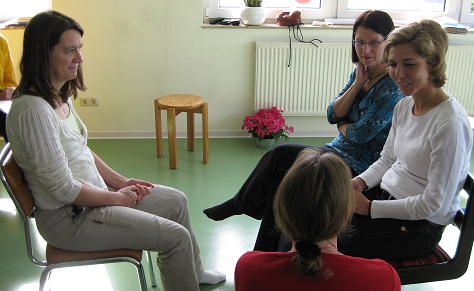
The encounter
The first encounter
The protagonists then play out the situation in their groups. The fourth participant takes note of the linguistic difficulties that arise in the group. Some scenes are then enacted in front of the whole group. Here, it is also possible to mix the protagonists from different groups; i.e. three protagonists from three different groups assume the three roles and meet.
Loading
After a scene has been played out in front of the whole group, the trainer can take a doubling position (sitting behind one of the protagonist) and expand and replay the sequence of the participant. She offers him more language and tools for his sequence and various ways to express himself. She takes particular note of the way the participant takes up the language offered and works around elements that he takes up readily and eagerly. She can do this with the other protagonists in the sub-group. The protagonists then meet again and the encounter is repeated with some changes to the parameters (see next section).
Retake techniques
The scene is reenacted; this time however, one parameter is modified: an aspect of a character ( age, mood, in a hurry), a change in the constellation such as a rotation (one protagonist, the same in each sub-group is exchanged, e.g. the applicant or marriage counsellors in the situations described above change the group they are in) or there is a change of roles (in the marriage counselling scene, husband and wife exchange roles). This change in the set-up leads to the language being reused, strengthened and expanded in a different context.
When the development of the scene becomes awkward or clumsy, we encourage the participants to interrupt the encounter and seek help from their subgroup. The encounter is retaken and the protagonists can, if they want, use the arguments and language prompted by their subgroups.
Writing exercise for this activity
Depending on the situation, various writing exercises can be used here. If it is about an upcoming job interview, a resume and/or cover letter to the company can be written, the trainer can then provide original examples from her own country. Marriage counselling can lead to note-taking by the counsellor, a letter to a lawyer, or to a contract between the two parties.
These writing activities are mostly done in the subgroups. The difference in levels between the participants is thus used constructively.
The chairs: an illustration of the difference between a therapeutic and an educational exercise
The original idea of this projection exercise came from psychodrama. I had the opportunity to experience the deep effect of such an exercise under the direction of Zerka Moreno at the International Center for Psychodrama in Barnstape in 1985.
Here is a brief description of the psychodrama exercise:
A empty chair is placed in front of the group and the participants are asked to imagine a person in the chair with whom they would like to get into conversation. This technique leads to the therapeutic work of a protagonist who, in a dialogue with the projected person, expresses things that she or he could or dare not say. It thus leads to an individual therapeutic work.
This particular setting should not be used in the educational field. For this reason, I have retained the principle of projection in this exercise, but have changed and “defused" its therapeutic aspects.
To transfer this exercise to a language course, I have changed three parameters:
- Instead of a chair, we place two or three chairs in the center of the circle and ask the group (instead of a single person) to first name situations that the chair constellation depicts in their opinion, and then they select one of these situations.
[Projection of Persons in the Psychodrama / Projection of a Situation in PDL]. - This situation is not determined by one participant, but by the whole group. The theme becomes a group theme.
[Individual projection in Psychodrama / Group projection in PDL]. - In psychodrama, we are dealing with real persons, in PDL with imaginary persons
[Real persons in Psychodrama / Imaginary persons in PDL].
These three significant differences to the Psychodrama exercise, including the protective function of the imaginary, lead to a completely different exercise, and allow it to be “de-psychologized" or "de-therapeutised”.
The imaginary, which is present in these three aspects, fulfils an additional protective function for the participants.
A note on written language
Writing is introduced gradually in a PDL course. During the first few days, the starting point is what happens in the group; the participants write down mostly in subgroups the phrases, expressions and sentences heard in the session which they want to see written and begin to develop an understanding of how the target language is written. Through the difference between the hypothesis of how something is written and the actual correct form, the learning process is developed.
Later on, writing exercises are directly interwoven with speaking activities. Independent texts are introduced gradually. They are selected according to dramaturgical criteria and harmonize with the dynamics of the group life. The work in subgroups makes it possible to use the differences in levels positively and also enhances the creativity in the group.

And grammar ?
Following instead of anticipating...
Grammar accompanies the acquisition process. It is not pre-programmed, but follows the participants’ wish for expression and the difficulties they hereby encounter. It is a result of the errors that arise in the group. Reflection on grammar follows the principle of being student-oriented; it only occurs when the participants’ questions lead to grammatical phenomena (which can often happen when a correction is not understood) or when problems arise where the trainer deems a grammar explanation advisable to avoid mistake repetition
.
Final Remarks
It is not easy to get a proper picture of how a PDL course progresses from a written description, as most activities are so dependent on the participants’ spontaneous wish for expression, and as life, so multi-facetted as it is, is difficult to put to paper.
The power and effectiveness of PDL lie not only on the build-up and selection of the procedures and exercises coordinated as to be in tune with the group, but also on the strong correlation of theory and practice (see the Characteristics of PDL on this homepage).
PDL makes it possible for the language to be experienced directly and actively, thus enabling a more effective acquisition. Each participant makes his way in the foreign language in his own rhythm, at his own pace, and can therefore move forward when encountering the language and those who speak it.
Links
You can read more on PDL on the following pages on this homepage:
The fundamental hypothesis of PDL
For a more in-depth analysis of the theory and practice of PDL, we recommend the PDL textbook: Teaching Myself, 1994, Oxford University Press.
If you can read German,we suggest:
Wege zu einer Pädagogik des Seins
and the bibliography:
Experience PDL in a foreign language...
If you would like to participate in a PDL course, check which courses are listed on the website of the PDL Association:
Translation: Robert Zammit

